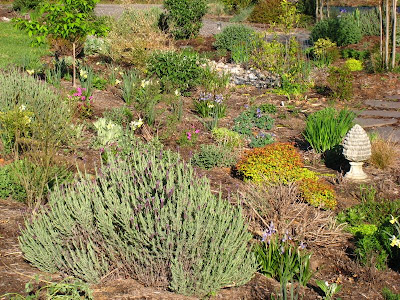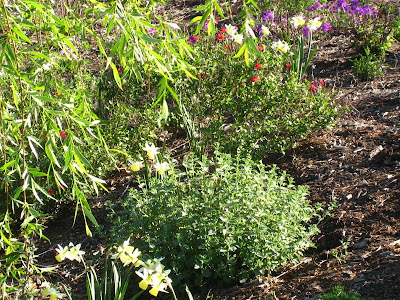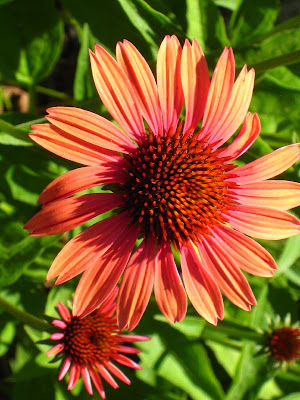 It's so easy to say nice things about agastache! At least in my garden and zone, it's close to perfection for a perennial.
It's so easy to say nice things about agastache! At least in my garden and zone, it's close to perfection for a perennial. Three years ago, I started with agastache 'Acapulco Salmon and Pink'. At least that's what my forum friends suggested as the correct variety. I lost the plant description tag a long time ago. I started with three of these agastache. Once I realized the long bloom season, I started dividing the agastache to increase the clumps in the butterfly garden. I've decided that the pink/orange tubular blooms work so well with the carmine and deep rose blooms of some of my front garden perennials, that I've started transplanting divisions to that area as well. Perhaps I'm going overboard and over-using this agastache. At this point, I feel like I can't get enough of a good thing. This agastache has bloomed continuously since it started back in early June. The blooms haven't faded. It's a nice, full shape of about 3 feet x 3 feet without any staking. It's rated for zones 5-10. The hummingbirds love it! If the color is too much for you, there are some milder colors available.
Here are a few photos from my garden. The agastache provide a colorful display in my butterfly garden.
Note: You can right-click and "open in a new window" to see these in a larger format. When you use a right-click to view a picture or website link, then you won't lose this main page.

Last year, I added 'Blue Fortune' which is a highly touted agastache among the plant retailers. This is another long-blooming agastache. However, the blooms have faded to a dusty blue in my full sun garden. If placed too close to pretty blues, it really looks a bit too dusty. I think it will work better beside some deep burgundy colors. So, I've done a bit of re-arranging to move this agastache away from my salvia 'Black and Blue'. This agastache is loved by Monarch butterflies. This is another tall agastache (3 feet), but not as wide as the 'Salmon and Pink' so you can tuck this narrow agastache in some tight spaces. It does need full sun to reach full height. I have some in part-sun that are only knee high.
Looking for a yellow/gold agastache, I bought a few seedlings of agastache 'Coronado' this spring. The color is more of a fiery gold/orange. However, I'm not put off by the color. I've moved the young plants close to my long-blooming sky-blue salvia uliginosa and my gold cestrum 'Orange Peel'. This is a shorter agastache of about 15" x 12". I cut a bloom and carried it around the garden to see what other colors worked with this. Well, the color works great with purples, blues, lavenders, and even my favorite echinacea 'Ruby Star' as it echoes the cone color. This agastache 'Coronado' is hardy in zones 4-8.
In my experience, the attributes of agastache are:
Deer resistant
Rabbit resistant
Long-blooming (June-frost for my garden)
Disease and pest resistant
Drought tolerant
About the only thing you need to do to take care of agastache is to plant them in full sun with well-drained soil. I leave the blooms on mine over the winter and cut it back in the spring. I don't deadhead any of these over the summer because they are always in bloom.
Agastache should be readily available at your local stores. However, there are many varieties available from the online plant retailers, too. Some of you have probably grown these from seeds. I've not yet tried that as the agastache seeds are the tiniest little things that I've ever seen! It's my understanding (haven't tried this at home) that you can tap the dried stems over a bowl to collect the seeds. Let me know how that works for you! :-)
I love the fragrance! I can walk through my butterfly garden and smell the minty foliage. Some of the blooms are also fragrant, depending upon the agastache. I'm now on the look out for more colors. Perhaps I'll add 'Purple Haze' or 'Black Adder' to my garden.











































